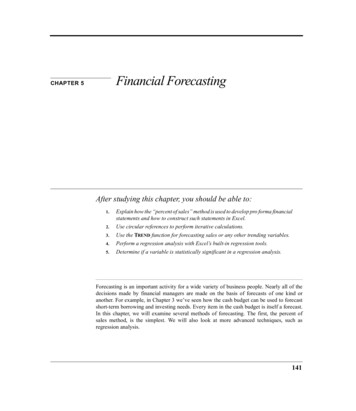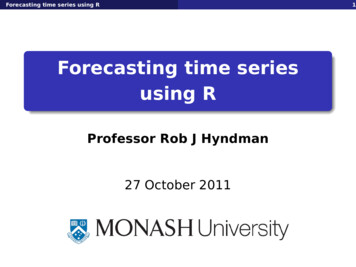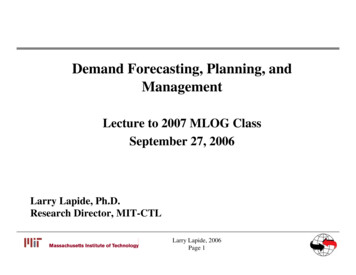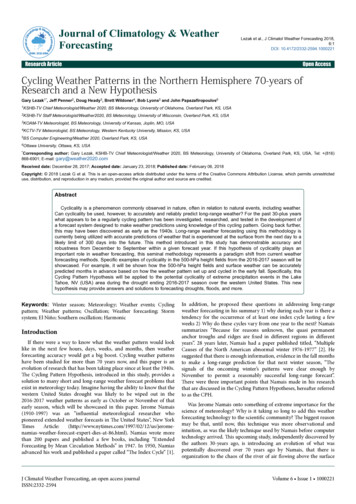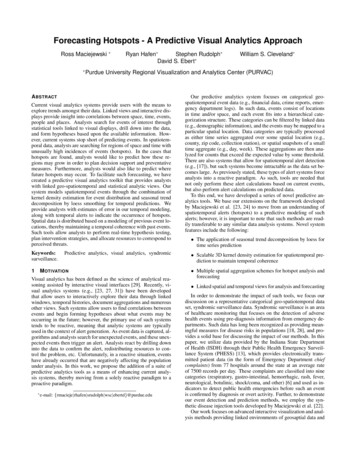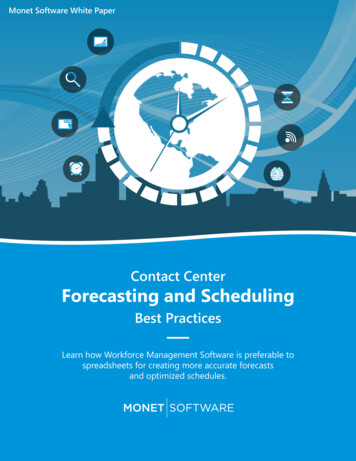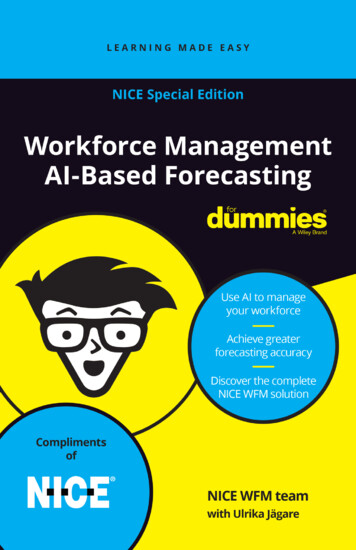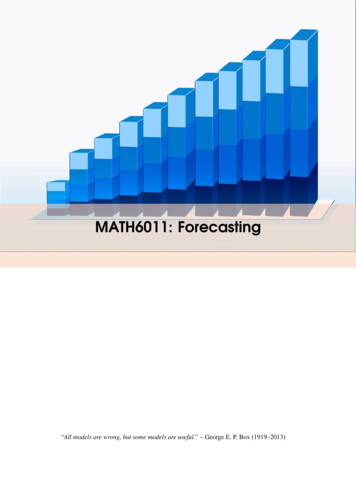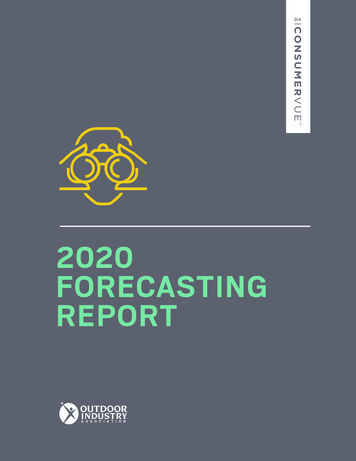
Transcription
2020FORECASTINGREPORT
TABLE OFCONTENTSThe U.S. Outdoor Consumer Segments3Introduction4The Five Macro-Shifts1. Rise of Millennials and Aging Boomers2. Urban Migration3. Obesity4. Heightened Attention on Health5. Hispanic/Latino Growth510141823Summary and Opportunities28Methodology and Sources30
THE U.S. OUTDOORCONSUMER SEGMENTSTHE ACHIEVEREverything Outdoors Performance-driven Engagement at its fullestTHE OUTDOOR NATIVEHighly Involved Experience-driven EstablishedTHE URBAN ATHLETEAthletic Competitive StressedTHE ASPIRATIONAL COREAdventure Seeking Aspirational Moderate engagementTHE ATHLEISURISTLow-Intensity Enjoyment Emotionally DrivenTHE SIDELINERLessened Involvement Inhibited InterestedTHE COMPLACENTExcluded Unmotivated UnfitPERCENT OF THEU.S. OUTDOORCONSUMERPOPULATIONSPEND PERYEAR ON OUTDOOREQUIPMENTHOURS SPENTOUTSIDE PERWEEK10% 7992712% 6372220% 7812414% 4762020% 2841912% 1621314% 143113
THE FUTUREOF THE OUTDOORCONSUMERThe outdoor consumer landscape is evolving, shifting in response toeconomic, social and demographic changes. As part of the OIA ConsumerVuesegmentation research, this report examines the significant impact andopportunities that five macro-shifts will continue to have on the outdoorindustry, as well as the seven segments of U.S. outdoor consumer population.Looking toward 2020, the outdoor industry is expected to face unprecedenteddisruption, induced by the perfect storm of shifting demographics, urbanmigration, the rise of obesity and a heightened emphasis on healthy living.1. Rise of Millennials and Aging BoomersAccording to the U.S. Census Bureau, the youngest Millennials will have reached adulthood by2020 and will account for 28 percent of the U.S. population, as well as 50 percent of the workingpopulation. Meanwhile, every single day, more than 10,000 Boomers reach the age of 65.2. Urban MigrationThe U.S. Census Bureau projects the urban population to account for 82.5 percent of the totalU.S. population by 2020.3. ObesityIf the obesity trend continues on its current trajectory, 42 percent of the U.S. population will beobese by 2020.4. Heightened Attention on HealthInstigated in part by the obesity epidemic and the rising cost of healthcare, there is a pushtoward creating a healthier America. Health initiatives aim to reduce the proportion of obeseadults to 30.9 percent and increase the proportion of healthy adults to 33.9 percent by 2020.5. Hispanic/Latino GrowthThe U.S. Census Bureau projects that the Hispanic/Latino population will grow from 17 percentto represent 19.4 percent of the total U.S. population by 2020 whereas Caucasians will drop to60.1 percent over that time period.4
RISE OFMILLENNIALSAND AGINGBOOMERSMillennials and their Boomer parents and grandparents represent theworld’s largest consumer groups. Consumers within these two generationsdiverge significantly in how they relate to the outdoors, as well as in theirattitudes, goals and purchasing habits. As these demographic groupsexpand and change, so will the size and makeup of the seven U.S. outdoorconsumer segments.5
Millennials: An Idealist TribeWho they areThe U.S. is home to approximately 85 million Millennials, a demographic group born between 1980 and2000. By 2020, the youngest Millennials will have reached adulthood; they will account for28%OF THE TOTALPOPULATION&50%OF THE WORKINGPOPULATIONThey control an enormous 1 trillion in spending power each year. Currently, 11.8 million Millennialslive in U.S. households with annual incomes exceeding 100,000.Millennials are more likely than members of other generations to be single, and they are also the mostethnically diverse adult generation.58%CAUCASIAN( compared with72% of Boomers and62% of Gen Xers)20%HISPANIC14%AFRICANAMERICAN5%ASIANWhat they valueAs a whole, Millennials demonstrate an emerging combination of idealism and self-esteem. They havebeen raised to believe strongly in their own abilities and are convinced that by collaborating with theirpeers they can achieve anything, including social changes on a global scale. These young consumerscrave shared, authentic experiences rather than the accumulation of material things. They seek outbrands that help them nurture their relationships and find fulfillment on a broader scale.How they experience the outdoorsMillennial consumers believe in the power of the crowd and feel a strong need to be together.The notion of belonging to a tribe defines them, with community goals trumping individualwants. They embrace community events and small groups, such as adult camps, Insta meet-ups,camping festivals and running clubs. he Millennial generation has largerTbuying power than other generations,and they are looking for an experience.”Rich Harshbarger, CEO of Running USAIn addition, Millennials also want to participate in multiple activities. Broadly known as “slashies,”they are true hybrid outdoorists, passionate about many different genres. Millennials often combinemultiple activities into one outing, leading to the recent bikepacking phenomenon, as well as the rise ofbackcountry splitboarding and powder surfing.How Millennials will shape the outdoor consumer segmentsThe Achiever, The Urban Athlete and The Aspirational Core segments skew young, which meansMillennials are more likely to be found in these segments, and as they enter adulthood, they are morelikely to age through these segments as well. Although Millennials are a diverse demographic, themajority’s mindset tends to mirror that of The Urban Athlete segment, whose main motivations foroutdoor activities are social connection with others, thrill-seeking and competition. Also, like The UrbanAthlete and The Achiever, Millennials enjoy a broad variety of outdoor activities and are likely to live inurban settings.6
Boomers: Active IndividualistsWho they areAmerica’s 50 demographic consists of nearly 100 million consumers, growing to 161 million by 2050.They representOwnAre responsible forOF TOTAL U.S.CONSUMER DEMANDOF THE NATION’SFINANCIAL ASSETSOF THE COUNTRY’SDISCRETIONARY SPENDING40%80%½With an average household income of 67,000, they spend around 284 per year on outdoorrelated products.Boomers are anywhere between the ages of 52 and 70, born between 1946 and 1964. Every day, morethan 10,000 Boomers will reach the age of 65. They are more likely than other generations to beempty nesters, female, Caucasian and living in suburbs or rural areas.What they valueUnlike Millennials, Boomers don’t worship the power of the crowd, instead they favor individuality.They believe in their earned wisdom and know they have something to contribute, both tosociety at large and within their family circles. After a lifetime of challenging conventional viewsof the generation before them, Boomers are not receptive to traditional marketing, preferringpersonalization and customization that leads to sensible products with clear functions andpractical utilities.The new face of old age is increasingly healthier,wealthier and more educated.”Joseph F. Coughlin, founder of Massachusetts Institute of Technology, “The Upside of Aging”Boomers also enjoy engaging younger generations in outdoor activities. They find pleasure andescape in the outdoors, and they want to share that with their children and grandchildren. Theybelieve their best years are ahead of them, and they emphasize family time and exploration.How they experience the outdoorsBoomers embrace custom experiences that prove their distinctive voices are being heard. They enjoyboth traditional and non-traditional outdoor activities and are often open to learning new skills.Nature tourism is a popular pastime, as Boomers relax outside or explore the natural world in RVs orvia prefab luxury-camping experiences.This older generation is becoming increasingly health and fitness conscious, joining fitness programs,taking advantage of fitness-tracking technologies, such as Fitbit and Lumo Lift, and using theinternet to discover or learn new outdoor activities.How Boomers will shape the outdoor consumer segmentsResearch shows that 61 percent of Boomers feel younger than their actual age, typically by anaverage of nine years. That statistic coincides with other findings that middle age now lasts nineyears longer than traditionally thought, thanks to the increased age of average life expectancy. Italso suggests that today’s Boomers plan to stay active longer than previous generations of seniors.Because Boomers currently account for a large portion of outdoor consumer segments that skewolder—The Athleisurist, The Sideliner and The Complacent segments—as they grow older and theirphysical abilities decline, it will lead to a decline in the sizes and impacts of these segments on thelarger outdoor industry by 2020.7
SEGMENT MEDIAN AGE The Achiever, The Urban Athlete and The Aspirational Core segments skew young, which means asMillennials enter adulthood, they are more likely to age through these segments as well. The Athleisurist and The Sideliner have the oldest median age - as they grow older and their physicalabilities decline, it will lead to a decline in the segment size and ANATHLETE4634THETHEASPIRATIONAL ATHLEISURISTCORETHESIDELINERTHECOMPLACENTThe arrows show an increase or decline in the segments size based on median age. No arrow means the segment in 2020 will not be as heavilyimpacted by this macro shift and will remain close to the same.8
The Futureof InnovationKeeping up with generational and consumer behavior shifts isa perpetual challenge. The following brands and retailers havetuned in to the mindset of Millennials and Boomers, tailoring theirapproach to the groups’ unique values.MillennialsThe North Face. After sponsoring a successful series of events for Hipcamp called “Under the Stars,” TheNorth Face will launch a line targeted to car campers, featuring a cooking shelter for groups, throwbackA-frame tents and two-person sleeping bags. These products strive to furnish a social gathering space foreveryone to hang out by the fire.GetOutfitted. Offering a streamlined approach to renting outdoor gear, GetOutfitted taps into multipleMillennial-friendly trends: the use of mobile devices and other technology, a willingness to rent versusbuy and a willingness to try a variety of sports and activities.Under Armour. Their tenacity and overall brand repositioning has captured the attention of Millennialsin the fitness sector, and now their sights are set on the outdoor industry. By aligning with diverse,contemporary athletes and amassing an impressive portfolio of wearable tech start-ups, they are lookingto engage future influencers and early adopters while encouraging crossover between team sportsloyalists and outdoor enthusiasts.BoomersTentrr. Providing customized, curated camping experiences ideal for Boomers, Tentrr takes the workout of camping by scouting new locations, arranging activities and allowing customers to camp in totalcomfort on platforms with canvas tents, while still immersing themselves in the outdoors.Filson. Continuing to cater to its loyal customer base, Filson takes its online approach to storytellingand iconic merchandise offline in its new flagship location in Seattle. A measured mix of Pacific Northwestheritage and American-made goods, Filson attracts Boomers with authenticity and commitment toquality manufacturing.Roadtreking. More than a million Americans are currently living in a recreational vehicle or motorhome, but it is the “gray nomads” who are driving the big bounce in the R.V. industry and have increasedownership rates by 20 percent, to 3.6 million. The Roadtreking blog and forum “celebrates the RV lifestyle”and offers an online community to share stories and connect with on the road.9
URBANMIGRATIONUrban areas are more attractive than ever before, and even in countrieswhere the population is edging downward, urban areas continue to grow.As of 2007, the majority of Americans were city dwellers, and by 2020,82.5 percent of the U.S. population is predicted to be urban. With 34 percentof outdoor consumers currently living in cities, a growth in this populationwill likely foster significant changes in the outdoor the consumer segments.ur·ban \' r-b n\An urban area has a population of 50,000 or more,according to the U.S. Census Bureau10
Who they areUrban outdoor consumers tend to be young, ethnically diverse and active. They are outside for 25 to30 hours per week and spend the most of any consumer on outdoor gear. These city dwellers are alsomarket influencers, providing product recommendations to friends and family.WHAT SCIENCE HAS TO SAYStudies have found that urban residents who visitnatural environments have lower levels of stresshormones immediately afterward than people whohave not recently been outside.What they valueUrban consumers don’t see themselves as traditionally outdoorsy; rather, they get outside becausethe activities they enjoy require them to go outside. The majority weren’t raised on typical outdooractivities like hiking or climbing but on team sports, and their participation in outdoor endeavors isas much about fitness, competition, socialization and intensity as it is about connecting with nature.They are style-conscious and seek multifunctional items that fit seamlessly into their lifestyles. Agrowing contingent of city apartment renters are skipping urban home ownership, choosing tomake their first purchase a more rural house, an important gateway to staying active outside, whilemaintaining their urban address and lifestyles.How they experience the outdoorsBusyness is an urban epidemic. Even so, fitness-conscious urbanites are dedicated to staying activeto maintain both physical and mental health. They make time to exercise and get outdoors beforeand after work, as well as midday. Urban residents embrace activities that they can integrate intodaily life, like running clubs and organized races, especially those that emphasize socializing. Bikecommuting and bike-sharing programs continue to gain momentum, as do indoor climbing andbouldering gyms.Although I love to plan big, adventurousoutings, some of them are often just aroundthe corner and right under our noses—even inone of the biggest cities in the world.”Bill Ulfelder, New York executive director of The Nature ConservancyCity dwellers are also engaging in micro-adventures, choosing quick hits of nature that are easilyaccessible via public transportation or a short drive, recognizing that simply walking in nature hasbeen linked to heightened physical and mental energy. Also, high-impact experiences, like ToughMudder, that are just as tough as the city itself provide a significant outlet for urban populations.Mirroring the daily hustle of living in a packed metropolis, these aggressive, rapid and social indoorand outdoor outlets are on the rise.How urban migration will shape the outdoor consumer segmentsThe migration of the U.S. population toward urban environments is likely to have the biggest impacton The Achiever and The Urban Athlete segments, which already draw from an urban population.Approaching 2020, this shift is likely to reduce the size of The Athleisurist, The Sideliner and TheComplacent segments, which tend to favor small town and rural environments.11
SEGMENT PERCENTAGE INCITY CENTERS OR OUTSKIRTS The Achiever and The Urban Athlete segments are anticipated to grow since they currently have thelargest percentage of urban outdoor consumers. The Athleisurist, The Sideliner and The Complacent segments tend to favor small town and ruralenvironments and are more likely to THEURBANATHLETETHETHEASPIRATIONAL ATHLEISURISTCORE27%THESIDELINER28%THECOMPLACENTThe arrows show an increase or decline in the percentage of the segment that lives in/near city centers. No arrow means the segment in 2020will not be as heavily impacted by this macro shift and will remain close to the same.12
The Futureof InnovationThe urban mindset can shift as rapidly as an urbanite’s fast-pacedlifestyle. The following companies are keeping their fingers on thepulse of change.Fjällräven. Bringing a Scandinavian approach to outdoor living to the market, Fjällräven has successfullyestablished itself as one of the go-to brands in the U.S. for dependable, long-lasting products. Withlocations in New York, Chicago and Seattle, as well as in key resort towns including Jackson Hole andBanff, they are successfully bridging the gap between urban and mountain living.The KinderBox. Ingeniously accommodating both hectic metropolitan schedules and the male urbanconsumer’s thirst for adventure, The KinderBox provides monthly deliveries of manly gear, much of itoutdoor-inspired. Its slogan—“Be bold. Be brave. Be ready.”—reflects the urban outdoor consumers’ aim toflow seamlessly from urban to natural settings at any time.Outdoorfest. A multifaceted yearly festival in NYC, Outdoorfest also publishes local trip guides thatprove you can live in a city and still enjoy the outdoors. The event has also fostered outdoor enthusiastcommunities in Washington, D.C. and Calgary, Alberta.Outlier. Hybrid travel, everyday and performance wear that emphasize both function and style is anideal fit for active city dwellers, as is the company’s direct-to-consumer approach.13
OBESITYAlthough obesity rates show some signs of slowing, if they continue at thepresent rate, 42 percent of the U.S. population will be obese by 2020. Thereasons for this trend go beyond overeating and sedentary lifestyles, withresearch suggesting that modern realities such as poor sleep, exposure topesticides and other chemicals, antibiotic use and hereditary factors alsoplay a role.14
Obesity statisticsOver the last 40 years, the collective BMI (body mass index) of the American public has shotup dramatically. Childhood obesity has more than doubled in children and quadrupled in adolescentsin the past 30 years.Approximately34.9%OF U.S. ADULTS ARE CURRENTLY OBESEwith higher ratesamong Hispanics52%and AfricanAmericans47.8%Overall, the population struggling with obesity tends to be lower income and live in small towns orrural areas. The Midwest is leading the epidemic, accounting for 30.7 percent of the obese population.There is no significant relationship between obesity and education among men. Among women,however, there is a trend: those with college degrees are less likely to be obese, compared with lesseducated women. Obese or plus-size groups who are active in the outdoors tend to be highly engagedon social media, with an emphasis on Instagram, Facebook and Twitter.The obesity mindsetObese Americans are a complex group, with widely varying levels of activity and outdoorengagement. Some have been more active in the past, but are now hindered by physical limitations,such as injuries or weight issues. Many participate in non-traditional outdoor activities, like simplyrelaxing outside, barbecuing, picnicking or walking for enjoyment.But even if this group is not traditionally seen as engaging in performance-basedactivities, it is clear many overweight people are as interested in getting outside withfamily and friends as other groups. More than 30 percent of outdoor consumers,including this demographic, want to try new outdoor activities and are making aconsiderable effort to spend more time outside. Building a sense of self-worth is seen asan important gateway to their ultimate goal of overall health and happiness, and they feelstrongly that every person, regardless of size, matters. The obese population doesn’t wantto be told they can’t do something nor have their bodies judged as an automatic indicationof how athletic they are.Some women believe that because theyhave curves they can’t run or shouldn’trun. Running is for every body anytime.”Erica Schenk, Women’s Running August 2015 cover modelPlus-size consumers are very supportive of each other, extending their own body awareness to ageneral sympathetic respect for social issues and other people who have been marginalized by society.They have a group mentality when it comes to their fitness activities and overall lifestyles. They arehighly engaged online and find motivation by interacting and sharing information with people whoface similar challenges.How obesity will shape the outdoor consumer segmentsThose in The Sideliner and The Complacent segments are more likely to see themselves as lesshealthy than their peers, even if they are involved in athletics or a fitness program, a pattern that isreversed among members of The Achiever and The Outdoor Native segments. Rising obesity rateswill likely contribute to the growth of The Sideliner and The Complacent segments.15
SEGMENT PERCENT THAT FEELTHEY’RE SOMEWHAT OR LESSHEALTHY THAN THEIR PEERS The Sideliner and The Complacent segments are more likely to see themselves as less healthy than theirpeers so a potential rise in obesity rates will contribute to the segments growth. A rise in obesity rates will have a declining effect on The Achiever and The Outdoor Native URBANATHLETE16%32%13%THETHEASPIRATIONAL ATHLEISURISTCORETHESIDELINERTHECOMPLACENTThe arrows show an increase or decline in the percentage of the segment that feels they’re somewhat or less healthy than their peers. No arrowmeans the segment in 2020 will not be as heavily impacted by this macro shift and will remain close to the same.16
The Futureof InnovationThe plus-size outdoor consumer gravitates toward companieswith positive, inclusive messages, as well as toward products thataccommodate the needs and concerns of people with larger bodysizes. The following companies’ open-arms mindset and messagingfurther inspire people to action.Buddha Body Yoga. Self-described “fat yoga” studios, like Michael Hayes’ Buddha Body Yoga in New YorkCity, strive to fight the industry’s skinny-person stereotype, while proving that those struggling withobesity can be both able and active. The studio adapts traditional yoga poses for people who are larger orinjured, enabling everyone to succeed and improve.#FitCurvesChallenge2016. Kymberly Nichole, plus-size owner of the holistic wellness coaching serviceWell Fit Curves, is demonstrating social media savvy with her #fitcurveschallenge2016. Each month,Nichole delivers a new health or fitness challenge, buoyed by the support of an online community andaccess to Nichole’s expertise.Penningtons. This Canadian retailer has become an advocate for body diversity and size acceptance,specifically for active, plus-size women. For example, their ActiveZone brand helps consumers selectclothing to suit their shape. Other initiatives include the yoga-focused #iwontcompromise campaign andthe Step Forward walking groups, which consist of three organized, 20-minute group walks with a goal of10,000 steps taken with friends.Juno Active. Anne Kelly founded this specialty retailer after realizing the plus-size market wasn’t able tofind quality, high-performance activewear. The company gives special consideration to innovative fabricsand performance tailoring, alongside stay-in-place fits, which have resonated with larger consumers.17
HEIGHTENEDATTENTION ONHEALTHA personal wellness mindset is at the forefront of current fitness and healthtrends. Consumers are spending record amounts, with categories such as healthyfood and nutrition seeing 108 percent growth since 2010. Health and wellnessis now a 3.4 trillion business, backed up by actionable data on the benefitsand necessity of achieving an optimal state of health—physically, mentally,emotionally and spiritually. Fitness has become an aspirational, total lifestylepursuit, impacting people’s associations with what they wear, where theytravel—even how they parent their children.Specifically, the concept of “innertainment” is being led by enterprisingvisionaries taking control of their own destinies, providing the holistic blueprintsfor living a simple, more balanced life. This change in thinking influences theindustry by bringing a focus to brain fitness and the strategies to achieve it,raising awareness of how physical workouts benefit the brain and recognizingthat simply getting outside, in any way, can boost mental performance.18
Health-minded statisticsNearly three-quarters of consumers think wellness is going to become more important in the future,and more than half of consumers wish they had more support in leading a healthy life. Globally, theoptimal age to achieve wellness is 34, and people are twice as likely to agree that it is easier for womento achieve wellness than men, a result of females being predominantly used as the face ofthis movement. Women say health and wellness goals are of ongoing importance to them and aresomething they plan to continue to invest in as they move through life.Women are forecasted to controlWOMEN MAKE UP THEMAJORITY OF THE WELLNESSMOVEMENT ADOPTERS75%OF ALL DISCRETIONARY SPENDINGWORLDWIDE BY 2028What the health-minded valueWellness as a total concept is shifting from a perceived luxury to a fundamental human right. Holisticwellness devotees seek to live healthier, more balanced lives, emphasizing mindfulness, meditationand periodic digital detoxification. They embrace communities of like-minded individuals whopractice together to help each other become more self-actualized.Scientific studies have shown that naturalenvironments can have remarkable benefitsfor human health. Natural environments aremore likely to promote positive emotions;walking in nature has been associated withheightened physical and mental energy.”Eva M. Selhub, M.D., and Alan C. Logan, N.D., authors of “Your Brain on Nature”Millennials who embrace the wellness movement expect their employers to provide morehealth benefits and place higher value on companies that support a healthy workplace.Regardless of age, health- and wellness-oriented people are highly educated regardinggeneral medical information and take an active role in monitoring their physical conditions.They favor holistic treatments whenever possible, from beauty and personal care productswith 100-percent natural ingredients to juicing and exploring Eastern medicines.Although they prioritize healthy living, this group also embraces technology through newhealth and fitness tracking apps, which 17 percent of all outdoor consumers use. Devotees ofwellness practices are also very active on social media, and one-quarter of all females 13 to 32years old, follow a “fitness guru” on social media. Demonstrating their wellness efforts—greenjuicing, destination yoga retreats or meditation events, for example—is a sign of status onsocial media, as well as a genuine opportunity to share tips, recipes and strategies.19
How the health-minded experience the outdoorsCreative systems designed for hitting pause and engaging in “me time” are increasingly popular,and these outlets encompass a broad range of activities. Popular approaches include personalmeditation apps, short nature breaks integrated into the workday and sensory immersion usingsound baths, floatation tanks, breathing sanctuaries and color-infused sleep pods.New mindfulness training communities have emerged that are not about competition or evenexercise. This type of group wellness often takes the form of organized meditation groups. Urbanretreats and pop-ups offering meditation, alcohol-free evening events, participatory art therapy,sensory baths and yoga in public spaces, instead of private studios, are all new parts of thiscommunal wellness trend.I think the whole country needs meditation.I don’t think it’s as much a question ofwho needs more or less—I just think it’san important thing for people to be awareof, and to understand that you can have apractice in your busy, modern lifestyle.”Jesse Israel, founder of The Big QuietMany wellness enthusiasts embrace eco-therapy, in which they find mentalhealing and growth through interaction with nature. Destination “fitcations,”close-to-home forest bathing and far-flung eco-camps are all built on theknowledge that simply getting outside is the cornerstone of human fitness.Destination wellness retreats, a 440 billion industry that currently accountsfor 14 percent of profits from tourism, will continue to grow as people look formore than basic vacations. Hotels are already introducing mid-meeting yogasessions, meditation zones and stress-management therapy for business travelerswho understand that emotional health directly affects work performance. Somecompanies offer employees a cash reimbursement when they go on a morning runor bike ride.How the health-minded will shape the outdoor consumer segmentsAn increased focus on creating a healthy U.S. population has led to a series of health initiatives toreduce the proportion of obese adults and increase the proportion of adults at a healthy weight.If these initiatives are met with success and more people move toward a healthier lifestyle, thelarger obesity shift could be offset—as those who make this commitment would likely lead to thegrowth of The Achiever and The Outdoor Native segments and the decline of The Sideliner andThe Complacent segments.WHAT SCIENCE HAS TO SAYStudies in the International Journal of Neuroscience andby the American Heart Association have concluded thatmeditation can help you feel younger, decrease your riskfor heart disease and stroke, help you lose weight andmake workouts more focused.20
SEGMENT PERCENT THATFEEL THEY’RE MAKING ASTRONG COMMITMENT TO AHEALTHIER LIFESTYLE Strong adopters of a healthier lifestyle, The Achiever and The Outdoor Native segments are anticipatedto grow. Committing to a healthier lifestyle will be more difficult for The Sideliner and The Complacent segments,leading to a potential NATIVETHEURBANATHLETETHETHEASPIRATIONAL ATHLEISURIS
migration, the rise of obesity and a heightened emphasis on healthy living. 1. Rise of Millennials and Aging Boomers According to the U.S. Census Bureau, the youngest Millennials will have reached adulthood by 2020 and will account for 28 percent of the U.S. pop
